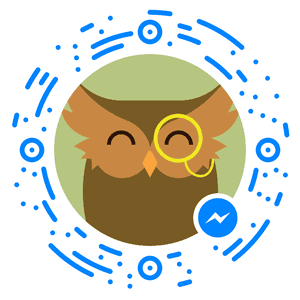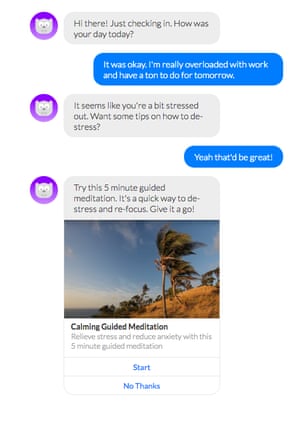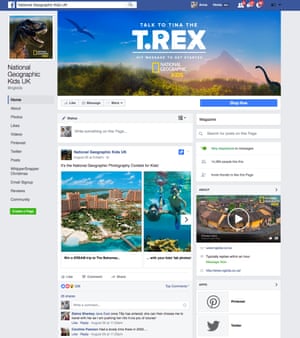Why Facebook and Microsoft say chatbots are the talk of the town

Software programmed to interact with humans is hot property in Silicon Valley, with potential benefits for businesses, consumers even the bereaved

Chatbots are the new apps, said Microsofts CEO Satya Nadella earlier this year. He was not the first senior tech exec to make this claim.
Threads are the new apps, suggested Facebooks head of messaging products David Marcus in January, referring to the threads of conversation in apps such as Facebook Messenger and WhatsApp.
Nadella and Marcus see chatbots computer programs that you interact with by chatting, for example in threads in messaging apps as an important new human/machine interface. Both of their companies have launched tools to help developers create these bots, and between April and September, more than 30,000 were made for Facebook Messenger alone.
Chatbots arent a new technology. The shopping and breaking news bots in Messengers ancestors are chatbots such as AI psychotherapist Eliza from the mid-1960s and Parry, a bot mimicking a human with paranoid schizophrenia, in the early 1970s.
(In 1972, they were thrown together for a bot-to-bot conversation, which Parry quickly steered down a rabbit hole of corrupt horse racing gambling.)
Since 1991, the chatbot equivalent of the Olympics has been the annual Loebner prize, which challenges bots to converse with responses indistinguishable from a humans. Questions in 2016 included: What does Brexit mean?; Would you like a cup of tea?; What do you know about the Turing test?; and a neat touch Do you dream of electric sheep?
But the chatbots on Facebook Messenger and other apps such as Kik, Telegram, Slack and WeChat arent dreaming of electric sheep. Rather than trying to pass for human, theyre unashamedly artificial, and focused entirely on providing information and/or completing tasks for the humans they interact with. If they have views on Brexit, theyre not letting on.
Talking to these chatbots works just like messaging a friend, once youve added them as a contact. Kik has its own bot shop to browse bots in categories including entertainment, lifestyle and games, while business messaging app Slack has a brilliant bots list for its corporate users.
Expectations of these bots are high, and immediate. As veteran developer and Twitter hashtag inventor Chris Messina wrote in his blog in January: 2016 will be the year of conversational commerce you and I will be talking to brands and companies over Facebook Messenger, WhatsApp, Telegram, Slack, and elsewhere before years end, and will find it normal.
He added: Im less interested in whether a conversational service is provided by a human, bot, or some combination thereof Over an increasing period of time, computer-driven bots will become more human-feeling, to the point where the user cant detect the difference, and will interact with either human agent or computer bot in roughly the same interaction paradigm.
This vision text chatting to brands and companies as well as to friends and family is whats driving the chatbot excitement in 2016.
Im excited about conversation as an interface, because for certain applications it feels like the most natural way to engage with a product or service, says Danny Freed, founder of a startup called Joy whose chatbot helps people to track their moods.

It may also be accessible to a wider range of people. Pete Trainor is director of human-centred design at Nexus, a digital agency that created an AI assistant called Luvo for the bank RBS. He is enthusiastic about chatbots reaching people who may struggle with other digital products.
Just in terms of engaging audiences who cant handle complex user experiences, theyre absolutely brilliant, he says. My mum wont use apps or websites, but she does text message and use WhatsApp to keep in touch because its conversational and thus very human by design.
A similar argument is made by NitinBabel, co-founder of Indian startup Niki, whose chatbot can book taxis, pay bills and order takeaway food among other tasks. He points out that in India, less than 2% of its billion-plus mobile users are transacting online, yet there are more than 10 times more users of messaging appsthere.
A similar trend exists globally. Chatbots have the potential to bridge this gap and enable users who are currently on the mobile internet just to converse with their friends and family to start utilising the platform for a much wider range of services, saysBabel.
One of the key services will be customer service. Tony Wright, strategist at marketing and technology agency DigitasLBi, points out that even if chatbots can handle simple interactions between businesses and their customers, they will have an impact. Waiting hours on the end of a line to give your energy supplier a meter reading could one day be as simple as tapping a few numbers into a tab within Facebook Messenger, hesays.
Jo Allison, consumer behavioural analyst at research firm Canvas8, which has published several reports on chatbots, agrees.
The potential chatbots have to improve customer service is exciting because its very real, says Allison, who sees the technology as an alternative to the almost universally unpopular interactive voice response (IVR) technology used by many companies customer service operations now.
Chatbots may be a logical next step, meanwhile, for companies that already have humans talking to customers on social networks such as Twitter from rail companies to travel firms and consumer goods makers but who may struggle to deal with an influx of questions andcomplaints.
Allison cites a recent study suggesting that almost 90% of messages for brands on social networks are ignored, while replies to the other 10% come after an average wait of 10 hours. Consumers expect a reply within four, she says.

Chatbots, backed by machine-learning technology, will be able to remember past conversations and learn from new ones, building up a stash of data over time to respond to a greater range of incoming queries.
Technology firm IPsoft has built an AI worker called Amelia that is designed to automate customer services. Enfield council in London has already struck a deal to use her to help residents find information and complete the initial steps in standard applications such as planningpermission.
She determines how to resolve a problem based on knowledge of the topic and process involved, says IPsofts European CEO Frank Lansink. If Amelia cannot answer a question, she will alert a human colleague, observe the following interaction and learn how to respond to comparable questions in the future.
While people involved in developing chatbots stress the positive aspects of this, it does raise two concerns. First: the privacy aspects of collecting, analysing and using all this data. Chatbots will need clear privacy policies just like apps do, but will the chatty mode of interaction distract us fromthat?
A number of existing bots and bot platforms are not designed with user privacy and security in mind, says Alan Duric, CTO of Skype rival Wire. Rather than users having to check to make sure that adequate precautions are inbuilt, security is a requirement that should be considered a mandatory part ofdesign.
Second, theres the impact on the humans currently working in customer service. In the shorter term, as Lansinks comments indicate, those human colleagues will still be essential. Further out, chatbots are part of the wider discussion about how software may displace humans in the 21st-century workplace.
Some companies see chatbots as helping us get more done in our own jobs. Business messaging service Slack, for example, has its built-in Slackbot and a range of bots being developed by third parties.
Bots are becoming part of our everyday working lives. We see bots scheduling meetings, helping salespeople access CRM information, managing to-dos, reporting on key business metrics and more, says Slacks head of developer relations, Amir Shevat.
Theres a lot of focus on consumer bots right now, but bots that solve for work will be where the real success will happen, because theres a clear set of problems to address.
This is a time of experimentation for the technology: many of those 30,000-plus Facebook Messenger chatbots are awkward to interact with, spammy and/or not useful at all. Its hardly surprising at this stage, but it should be a warning against grand claims of a chatbot revolution.
It got really overhyped really quickly, admitted David Marcus last week. This is a long journey, and you have to start somewhere.
Experts agree that an awareness of chatbots weaknesses as well as their strengths is important. Rachel Barton of consulting firm Accenture Strategy, says: Receiving scripted conversations, being directed to self-service channels or automated help can feel frustrating in particular instances when customers need help and support.
Dylan Bourguignon, CEO and founder of insurance startup So-Sure, says: My take on chatbots is always: what do customers want? My answer to that is: a quick, correct and complete answer to their question. Until AI is able to do that, humans are the best respondents.
Pete Trainor says that Nexus spent nearly six months working on the personality of RBSs Luvo assistant before coding any tech, to minimise the risks of frustration on the part of the humans it chats to. I think the developers need to spend a lot more time focusing on the personality and psychology of their bots, he says. We wanted to ensure the profile was right and the language was approachable. Implementation is relatively straightforward: its the words in the chats and the sentiment analysis of the conversations theres where the real magic lives.
Lawrence Wu, developer of a chatbot called Jarvis, which acts as a reminder service for its users, also uses the magic word, but suggests that it comes from the combination of bots and humans behind the scenes. The most exciting thing about chatbots, as a medium, is allowing humans to step in when needed, he says. Chatbots in themselves arent revolutionary weve had phone trees and robotic dialogues for a while but when paired with human intelligence for tasks AI hasnt quite gotten to yet, these bots seem like magic.
Sometimes the combination of humans and bots can be toxic, as Microsoft found out earlier this year when it launched a chatbot called Tay on Twitter. Designed to mimic the linguistic tics of a late teenage girl and learn from the humans it interacted with, Tay was manipulated by mischievous internet users, and managed to praise Hitler, deny the Holocaust and accuse George W Bush of the 9/11 attacks before being taken offline by Microsoft within a day oflaunching.
Your energy companys Facebook Messenger bot is unlikely to be as outrageous, but experts think Tay is a valuable reminder that there is more work to do around AI and chatbots.
AI-driven programs have huge potential so long as they can get better at understanding language contextually, says Jo Allison of Canvas8. And learn to avoid being tricked into promoting genocide.
Other experts warn of the risks of getting carried away with the chatbot hype. Not all services can be shoehorned into a chat-based dialogue, says Tim Rea, CEO of messaging app Palringo, which has a number of bots.
Sometimes a conversation is just not the best interface suited for the task, says Lawrence Wu of Jarvis.
Dont build a chatbot just to follow a trend; build a chatbot if it helps you solve a problem better, or get to market faster, adds Joys Danny Freed.
Developers are enthusiastic about how the current generation of text-based chatbots will evolve. Voice-based technologies such as Apples Siri and Amazons Alexa soon to make its UK debut in the Echo speaker show one path forward.
Right now, the interface for chatbots is text and buttons. Eventually it will be voice, like with Amazon Alexa or Siri, says Syd Lawrence of We Make Awesome Sh, the studio that recently created a Facebook Messenger chatbot for musician Hardwell. It will be like having a virtual PA helping them with all parts of their life.
That said, its important to remember that consumers want less, not more, interaction, says Daniel Hegarty, CEO of Habito, which has just launched a chatbot mortgage adviser in the UK. If Alexa can order my shopping while I shout it out across the kitchen, thats great, but the second it takes longer to say than to type, the utility is destroyed.
Tony Wright thinks that chatbots will also appear in digital services beyond messaging apps. It could be interesting to see how chatbots might be built into the likes of Netflix and Spotify, he says, suggesting that bots could build on the current recommendation features these services have.
You might want to quickly establish who directed something or what else a particular actors been in, he says, before delivering a warning that chatbots must not be gimmicks.
The likelihood of a chatbot becoming popular depends on how entertaining or useful it is. Does it really serve a purpose or enhance someones experience? says Wright, before making a comparison that may give Microsofts Satya Nadella pause for thought.
Theres a reason why the personified paperclip in the corner of Microsoft Office isnt around anymore.
Our pick of the chatbots
XiaoIce
Tay may have been led astray by humans (see main article), but Microsoft has another chatbot that has been less problematic. XiaoIce has been living on Chinese messaging app WeChat since 2015, and has had more than 10bn conversations with people since.
Fitmeal
Millions of people are already tracking their calorie intake using smartphone apps. Fitmeal is a chatbot that turns this into a conversation, prompting you to tell it what youve eaten and drunk, calculating the calories, and reminding you to check in.
DoNotPay
The self-described worlds first robot lawyer was created by a 19-year-old student to automate the process of appealing against parking tickets, winning more than 160,000 cases since its launch last year. He has since expanded toflight-delay compensation.

Eternime
This startup wants you to live for ever. Or, at least, live on after your death in chatbot form. It collects your thoughts, stories and memories, curates them and creates an intelligent avatar that looks like you to interact with your descendants.
Hardwell
Dance-music star Hardwells chatbot is a cut above the marketing-focused herd. Its as much about fans chatting to him, and voting on their favourite tracks for his podcast as promotion for his music. Two-way interaction.
Niki
Indian startup Niki launched in 2015, before the current wave of chatbot hype. Its an all-purpose helper, booking cabs, paying bills, recharging phone credit and even ordering takeaway from Burger King for its growing number of users.
Joy
Messaging apps and their notifications could be seen as a source of stress in our daily lives. Joy wants to have a more positive effect, tracking mental health by asking you once a day how you are and analysing the results, as well as offering stress tips.
Jarvis
Chatbots could be very useful at making up for the flaws in human memory. With Jarvis, for example: you can tell him to remind you to go to the gym, take the bins out or book tickets through Facebook Messenger, and get pinged at the appropriate time with a reminder.
Habito
Launched earlier this month, Habito is described as an artificially intelligent digital mortgage adviser. It uses multiple-choice questions to gauge your needs, and then scans hundreds of mortgage products to suggest the ones that might suit you without a hard sell to choose one.

Tina the T-Rex
Tina is the work of National Geographic: a Facebook Messenger bot pretending to be a Tyrannosaurus rex that children can ask questions about all things dinosaur. Its an early example of a chatbot interface used for primary-level education.
Acebot
Acebot is one of a growing number of chatbots on the Slack messaging service, for workplaces. It will manage your expenses, keep track of your to-do list, quickly poll your colleagues and handle a range of other digital office tasks.
Massively
Massively is one of the most interesting attempts to turn chatbots into interactive fiction. Its tech delivers stories through text conversations with their characters, both in its own app and in messaging apps such as Kik.